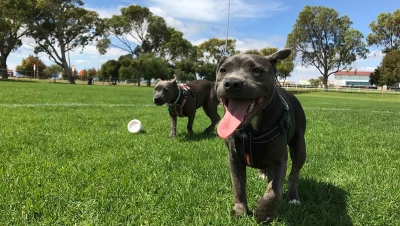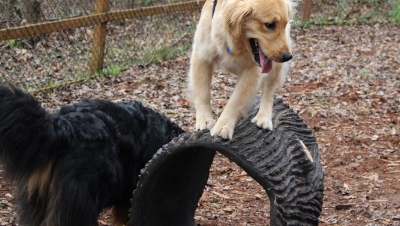5 Signals That Your Dog is Stressed at a Dog Park
Dog parks are a great place for our four-legged friends to socialize, play, and exercise.
That doesn’t mean all dogs enjoy trips to the park though. Some dogs may find the experience stressful, especially when there are lots of other dogs around, so it’s important to know the most common canine stress signals.
Here are the five most common signs that your dog is stressed at the park. If you notice these signals, make sure you calmly remove your pet from the situation.
-
Yawning
When a dog yawns in a stimulating situation, it’s a clear indicator that he is stressed and trying to relieve tension.
In most cases, the best way to identify a nervous yawn from a genuine tired or bored yawn is to focus on the dog’s facial muscle tension.
If he looks tense rather than relaxed, it’s a stressed yawn. As noted in this article in Nature, “yawning, body shaking and crouching are indicative of acute stress in dogs”. So owners should take any out-of-character or unexpected yawning as a definite stress signal.
-
Pinned-back Ears
It’s important that all owners make a habit of observing their dog’s ear position. Admittedly, this sign is much more evident in dogs without floppy ears. However, all dogs that are experiencing some form of stress may carry their ears much further back than usual.
This behavior is one of the most clear-cut indicators that your pup isn’t feeling happy. If your dog is displaying pinned back ears at the dog park, it’s best to take a time-out and go for a walk together, perhaps heading back to the park on your way home or at a later date.
-
Lip Licking
Classed as a subtle sign of anxiety, lip licking in the absence of food is often overlooked.
When you take your dog to a new dog park and he feels a little stressed or overwhelmed, he will often start to produce extra saliva which results in frequent lip licking.
While a little lip licking is to be expected in a new situation, make sure to pay close attention that no other canine stress signs are being displayed and provide reassurance.
-
Hiding
Whether it’s behind objects, yourself, or other people, if you notice that your dog is starting to hide, he is definitely anxious. It could be that he is intimidated by another dog or elements in his surroundings.
This is especially true with young or nervous dogs that need longer to acclimatize to some dog parks. Better to have short, fun visits that they will remember positively. Hiding, whether or not it’s accompanied by other dog stress signals, is a strong indicator of anxiety.
-
Low Tail
A low tail is a clear indicator of stress. While almost all owners will pick up on the tail tucked between the legs - a classic signal of fear - not everyone realizes that a low slow-wagging tail can also be a signal of wariness and stress.
Just like ear position, owners should observe their dog’s tail position and motion throughout various situations to get a better understanding of the subtleties involved in reading their pet’s mood.
A low tail signals stress and a low one tucked between the legs is a clear sign that your dog needs to leave the park and de-stress.
Summary
If owners pay close attention to their dog’s behavior signals, the dog park will become an even better place with improved social interactions between pets and their owners. Make sure that you are responsive to your dog’s stress signals, and if displayed, cut playtime short and compensate for it with a stress-free walk or play at home.
Dog play parks are fun and exciting places for dogs, but if your pup isn’t quite feeling up to it, it’s best to save the experience for another time to avoid unnecessary stress. It’s also important to remember that not all dogs enjoy dog parks, so if your dog is often stressed there it’s a good idea to find alternative activities.










